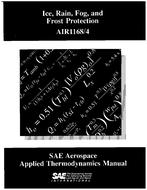Description
The ability of aircraft to fly in adverse weather conditions is a requirement for most military and commercial aircraft. Ice buildups in critical areas can affect flight safety by adding drag and weight and thus adversely affecting stability. Supercooled water droplets may exist in clouds at ambient temperatures far below the freezing point. When the droplets are disturbed by an aircraft flying through them, the droplets will impinge and may freeze on airfoil surfaces, radomes, engine inlets, windshields, and other areas, resulting in weight and drag penalties or obstruction of vision through transparent surfaces. Some means, therefore, must be provided to prevent large ice buildups in critical areas. The inner surfaces of most cockpit transparencies are susceptible to condensation in the form of fog or frost during most normal aircraft operation, particularly when descending from high altitude flight, unless fog and frost protection systems are provided. Fog will form on the inside surface of the windshield whenever that surface is below the cockpit air dew point. If the surface temperature is below 32 degrees F, frost will form. Removal of rain from the windshields to maintain pilot visibility is accomplished by hot air jet blast or by windshield wipers. A rain repellent fluid is sometimes used in conjunction with either system for increased rain removal efficiency.
Product Details
- Published:
- 07/01/1989
- File Size:
- 1 file , 6.2 MB
